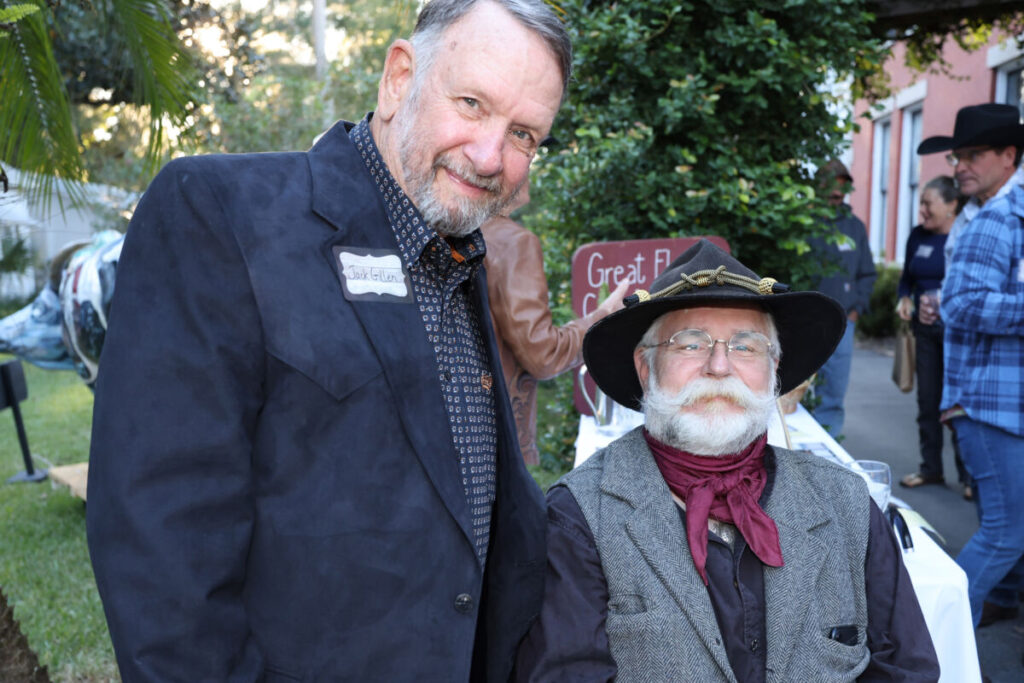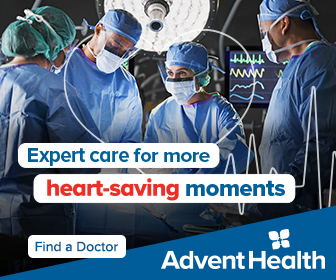History on the hoof
The Great Florida Cattle Drive and Ponce de Leon 1521 Herd celebrate 500 years of cattle in the Sunshine State.

Jack Gillen and Doyle Conner Jr. pose for a picture during the Great Florida Cattle Drive social gathering event at Herlong Mansion in Micanopy on Thursday, Oct. 20, 2022. The Great Florida Cattle Drive is scheduled for Dec. 4-10 and will be honoring 500 years of cattle in Florida. It is sponsored by the Florida Agricultural Museum. Horse riders, walkers, wagon and buggies will drive 1,000 head of cattle east of Kissimmee and end at the Silver Spurs Arena in Kenansville.
If settling into the saddle and driving a herd of cattle through palmetto prairies, boggy swamps and rolling pastures is on your bucket list, you still have time to register for the Great Florida Cattle Drive 2022—Celebrating 500 Years of Cattle in Florida. Organizers avow that you will be well fed, highly entertained and likely make lifelong friends.
The Florida Cow Culture Preservation Committee (FCCPC) is preparing for a quincentennial celebration from Dec. 4-10, when cow hunters will drive 1,000 head of Florida Cracker style cattle through central Florida, culminating with a grand “when the cows come home” party that will be open to the public.
The Great Florida Cattle Drive is a nonprofit event put on by volunteers and sponsors and is registered 501(c)(3) entity as part of the Florida Agriculture Museum.
This will be the fourth drive. The first, in 1995, was conceived as a reenactment to celebrate Florida’s 150th birthday. It took 1,000 head of certified Florida Cracker Cattle and about 600 riders, 600 horses and 25 wagons over 100 miles through cow country. The endeavor marked the formation of the FCCPC. The second drive, with about 500 head of cattle and 450 riders, took place in 2006. The third drive was held in 2016 and the participants, which included a group of veterans from the Wounded Warrior Project, had to endure extremely wet and cold conditions.
According to Florida state archives, the term “Florida Cracker” is thought to refer to the cracking sound made by the whips used by early settlers to herd cattle. It generally describes a class of early pioneers, mainly farmers and cattle ranchers. Cracker cowboys are sometimes called cow hunters because they allowed cows to wander open ranges. When it was time for branding or driving cattle to market, the Cracker cowboys would search the woods and round up the cows with the aid of whips and cattle dogs.
Drive chairman Doyle Conner Jr., the “Trail Boss,” has been a key player in all of the FCCPC cattle drives. He is a longtime wrangler, having been taught by his father, Doyle Conner, a fifth generation Floridian whose family raised cattle, grew strawberries and cut timber. The senior Conner was in the Florida House of Representatives for 10 years and was Florida’s Commissioner of Agriculture for 30 years.
With sparkling eyes and an impressive handlebar mustache, and sporting the de riguer cowboy hat, bandana and giant belt buckle, Conner Jr., seated next to the check-in table on Thursday during a special event at the Herlong Mansion in Micanopy, drew crowds of people eager to say hello, shake his hand and have a photo taken with him.
In a charming southern drawl, he explained some of the history behind the first drive.
“We started it in ’95 to celebrate Florida’s sesquicentennial. We turned 1,000 head of cattle from down around Yeehaw Junction up to the rodeo in Kissimmee and they said it was the largest event of the sesquicentennial,” he said. “I asked the Seminole Tribe if anybody had asked them to be part of the sesquicentennial and they said no. I said, ‘Well, you guys took care of the cattle for damn near 100 years so you need to be part of our deal.’ So, they did. They played a big part and have ever since.”
He recalled that about five years later, “My people started saying we’ve got to do that again and I said, ‘Why?’”
“They got me by saying that at the end of the first drive I had said that I would not take a million dollars for having done this but I wouldn’t do it again for a million,” he stated. “But they also said that everybody on that drive had the experience of a lifetime and my cow boss said, ‘What right have you got to not let other people have that same thing?’ So, we did it.”
The plan was to do the drives every 10 years. But, Conner said, after the 2016 drive, “We knew we had the 500th anniversary of the first cows and first horses to ever step foot in America coming up so we decided to do it in five years instead of 10, but then COVID got in the way. So now we’re a year later.”
Conner vividly remembers some of the challenges of the first drive.
“We had ambulances and EMTs, and radios the sheriff’s department gave us. After the cows went out, the wagons went, then people started out on horseback. There were still people in camp and somebody came over and said, ‘Doyle, we need an ambulance. Somebody got kicked in the jaw.’ Thirty minutes later, ‘Doyle, we need the other ambulance. Looks like somebody is having a heart attack.’ Then they called me and said, ‘We need the veterinarian. One of your big steers just died.’ And I said, ‘Have y’all ever been on the Santa Fe Trail? Let me tell you, from where it starts to where it ends, there are crosses all the way across America and it looks like we’re gonna have the same thing…”
But that streak of bad luck turned out well in the end.
“The guy that had the heart attack came back from the hospital and got on a wagon and came in with the cows. The guy that got his jaw broke, he was all wired up, but he went to helping the cook,” Conner shared.
He said he and his team have spent three years planning this year’s drive.
“We’re gonna start at Deseret Ranch, which is the largest ranch east of the Mississippi and has the largest commercial cow herd in America, with right around 300,000 acres and right around 40,000 head of mama cows. We’re going to drive through their property twice and zig zag our way to the Silver Spurs practice arena in Kenansville,” he explained.
The Deseret Ranches of Florida, in Saint Cloud, got its start in 1949 and is an operation of The Church of Jesus Christ of Latter-day Saints.
During the cattle drive, the participants camp primitively and are only allowed to have 60 pounds of personal gear. Meals are provided and there will be entertainment in the evenings.
“But there are no motorhomes or showers or stuff like that,” the Trail Boss noted.
“It will be the experience of a lifetime; I assure it,” he added. “I thank the Lord this will be my fourth experience of a lifetime. You’ll make friends that you’ll have forever. And the last one, it rained for two days but they just sucked it up. Our motto is, ‘This ain’t for sissies.’”
Seasoned Rider
Ocala Realtor Wendy Wilson was on that 2016 drive when the weather turned sour.
“One night a downpour left a lot of people with flooded tents,” she recalled. “The next morning, there were clothes hanging all over the palm fronds and boots turned upside down by the camp fires.”
Wilson was born and raised in New York and moved to Florida when she was 22 years old. After she graduated from high school, she became a veterinarian technician.
“Moving to Florida was the best thing I ever did. I met my husband of 42 years in St. Petersburg. We were both lifeguards and he was going to college. His parents had a house in Dunnellon on the Withlacoochee River,” she said. “We drove through Ocala one day and I was in love. All the beautiful farms, and everywhere I looked were horses. I said to him, ‘This is where I’d like to live when you graduate.’”
Wilson got her first horse when she was 36. She took up trail riding, endurance racing, obstacles and cowboy mounted shooting.
She said, however, “My dearest friend, who taught me so much about horses, said to me, ‘You’re not a cowgirl ‘til you go on the cattle drive.’”
“My memories of the drive in 2016 were that I felt like I was in heaven, with so many horses, amazing wagons and the atmosphere of fun,” she recalled. “It didn’t matter that it poured and some people’s tents got flooded or that it was cold. Memories of a herd of horses running out of a stand of trees on a beautiful prairie and the wranglers going to head them off, incredible sunsets, campfires keeping us warm, the cattle in such large numbers going where they’re supposed to because of cowboys and dogs working together. I decided to do it again because it’s an adventure I wouldn’t want to miss.”
Florida Drive Newbie
Jennifer Schuck grew up riding in a “horsey” community west of Minneapolis and was involved in dressage, eventing and fox hunting.
“But I always wanted to be a cowgirl,” she said.
“I got to go on The Great Montana Centennial Cattle Drive of 1989. I had just graduated from college and was an art director at an advertising agency. My creative director and Continued from page B1
my senior art director wanted to go too, so we all went,” she said.
Schuck had a horse training and horse showing business in Minnesota when started doing horse shows in Florida in the winter.
“We’d stay down in Wellington and do dressage and show jumping there and then we’d come up here for the eventing,” she explained. “My parents retired in The Villages and we moved here six years ago.”
Schuck and her partner Jami own and operate the Diamond Oaks Farm in northeast Ocala.
“We have a stay and ride. We offer accommodations for the seasonal people cause that’s what we were, snowbirds who came to horse shows. I still teach lessons,” she said.
As for why she wants to do the cattle drive, Schuck said, “I love adventure and the history of Florida is fascinating.”
The Circle Boss
Jack Gillen, who lives in Shiloh in northwest Marion County, is a fifth generation Floridian and has a long history of working with Cracker cattle and horses. He has served on the boards of the Florida Cracker Cattle Association and Florida Cracker Horse Association. He also worked as the park manager for the Paynes Prairie Preserve State Park for about 21 years.
“I was always fascinated with these horses and cattle. Back when I was a kid, we just called them woods horses and cows. Then I became manager of Payne’s Prairie. We had our herd of Cracker cattle there and Cracker horses and some bison. They are part of our heritage,” he said.
This will be Gillen’s fourth cattle drive. When the participants arrive, they are separated into “circles,” which are denoted by different colored bandanas. Gillen is a Circle Boss.
“The state is divided into five regions and I’m the Circle Boss for this region,” he explained. “I’m in charge of making sure people are safe and get to the other end alive.”
He anticipates about 50 to 75 cow hunters will be in his circle this year. An important part of that circle is his wife, Carol, who serves as a truck driver to move the participants’ gear from camp to camp and also as a relief rider.
“I give people a break when they are tired,” she offers. “We share a horse, a Cracker mare, and she is going to take a veteran on this drive.”
Family friend Peggy Jordan, of Monticello, in north Florida, did the drives in 2006 and 2016 and is looking forward to this one.
“I was 76 on the 16th of October,” she shared proudly. “I have a great quarter horse mare that is lazy and quiet and sweet and she takes good care of me.”
When asked about some cattle drive memories, Jack Gillen said one downside is that some participants “are just not cut out for it. They think they are and then they get there and they’re ready to go home. And some people just really don’t appreciate what we’re doing.”
One of the most exciting things that ever happened was what he called “a little stampede.”
“We were going through a big palmetto prairie and there was a deer lying down and nobody saw it till somebody’s horse practically stepped on the thing,” he recalled. “She shot up the air and jumped over the cows right beside us and about 100 of them took off. My reflexes kicked in and I took off with them. I had to cut them off and slow them down and turn them back. It was pretty exciting.”
The Ponce de Leon 1521 Herd
According to the Florida Department of Agriculture, in 1521 Spanish explorer Juan Ponce de Leon brought some Andalusian cattle and horses on his second expedition to the New World. He landed near what is now Fort Myers. These were the first cattle and horses to set foot in what is now the United States.
The Spanish explorers were forced back to their ship by Indians and de Leon was wounded and died. It is thought that the animals were left to run wild. Other conquistadors soon showed up and also brought cattle and horses. In 1540, Don Diego Maldonado brought a large herd of Spanish cattle and horses to the Pensacola Bay area to supply the expedition of Hernando De Soto but could not make contact with the conquistadors and it was reported that many of those heads of cattle also were left to run wild.
As part of this year’s quincentennial celebration, the FCCPC partnered with artists to create the Ponce de Leon 1521 Herd of seven life-size painted fiberglass Cracker bulls that represent the cattle brought here in 1521. The bulls, each with a different theme, have been traveling the state and were on display Thursday evening during the event in Micanopy.
The bulls and artists are “Stew,” by Deborah Herbert; “Quinientos,” by Jerri Phillips; “Cow Hunters,” by Hobby Campbell; “Ponce,” by Linda Ballantine Brown; “Rodeo” by Sadie Dymmek; “Cracker Cow At Home,” by Monica Goodwin Turner and “Everglades,” by Susan Strum Menand. The painted statues will be auctioned off to support the cattle drive and the Florida Agriculture Museum.
Registration for this year’s Great Florida Cattle Drive ends Nov. 1. To learn more about the drive and the public Trail’s End Frolic event on Dec. 10, go to greatfloridacattledrive.com





